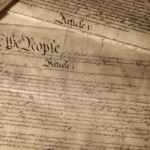Earlier this month, a leaked draft of an executive order titled “Make Federal Buildings Beautiful Again,” which called for the use of classical and traditional styles of architecture for new federal buildings, appeared in various news outlets, beginning with Architectural Record. It mattered little that it was an early draft; that the order included limitations and exceptions to the classical mandate based on location, budget, and other extenuating circumstances; or that the order attempted to make the federal contract procurement and design approval process more transparent and democratic. The cat was out of the bag, and the old “style wars”—which had remained simmering on the back burner of public consciousness and had shown certain small signs of abating in recent years—were instantly brought back to a boil.
Predictably, reactions from national press, journals, professional organizations, and architectural institutions were as swift as they were uniform in their denunciations of the proposal. They varied mostly by degree, from outrage to disavowal, and they came even from corners of the architectural world known for the teaching and promotion of classical and traditional architecture, where support would have seemed most likely.
It is worth wading through some of these responses before addressing the actual content of the order and examining its strengths and weaknesses. That’s because the significance of this order lies as much in the conversation it has sparked as in its actual content.
Does Totalitarianism Lurk Behind the Pillars?
Start your day with Public Discourse
Sign up and get our daily essays sent straight to your inbox.While more than a few commentators imputed to the authors of the draft order mere racism and ignorance, others saw more extreme visions of gulags and concentration camps—dressed in stately columns, marble revetment, and perfectly proportioned porticos and pediments—lying just around the corner. Some argued that the style mandate amounts to fascist authoritarianism or even totalitarian dictatorship, trotting out the usual examples of Mussolini and Hitler. Of course, such commentators prefer not to delve into the long and sordid history of modernist architecture and the links between its founding architects and Nazi, fascist, and occultist movements. Architectural “styles” know of no political boundaries, and they are used by left and right, knave and saint alike. Guilt by association is a game played by small, partisan minds who wish to smear without engaging the real issues and arguments at play.
Other critics asserted that the style mandate stifles artistic creativity and freedom of expression, since any stylistic recommendations or restrictions amount to an act of architectural tyranny that undermines diversity and the very democratic ideals that its architecture is meant to symbolize. Proponents of these latter charges are either being disingenuous, or have apparently gone too long without a client that makes aesthetic demands (the government and its people are a client after all) or without facing a historical review board that requires them to fit the historic character of a place. They also fail to reckon with the anti-democratic nature of the current federal contract awarding process and of the lack of public comment in the design process.
Advocates of contemporary architectural modernism are never forced to give a convincing, public account of how modernist architecture (in its various styles of internationalism, brutalism, deconstructivism, parametricism, hypermodernism, etc.) somehow symbolizes our American ideals and aspirations, or advances the republican virtues and cultural heritage of our democratic nation. Nor do they explain how its forms and materials (often low in legibility and lovability, while high in latent energy and maintenance costs) contribute to civility and sustainability rather than to social and environmental agita.
It can feel as though one is speaking into the void when pointing out that yet another glass and metal facade does not the democratic virtues of “transparency” or “diversity” evoke, nor the variety of regional and cultural expressions manifest. Bare assertion of such qualities is enough when professionals and their critics can take shared suppositions for granted; when public opinion can be safely ignored; and when taxpayers remain on the hook for the privilege of living with these architectural experiments in egotistical self-expression—once budgets are exceeded and maintenance bills come due—repeatedly. But as Justin Lee derisively opines, “The idea, suggested by several critics of the draft executive order, that modern and hypermodern designs are somehow more emancipatory or better suited to ‘diversity’ is—not to put too fine a point on it—horsesh**.”
The History of the Guiding Principles
Much of the criticism of the draft order seems to stem from the unstated position that stylistic neutrality, and deference to professionals in regard to federal architecture, are the only position a democratic government may reasonably hold, short of tyranny. As others have pointed out, however, it is a matter of historical record that the classical was previously the “official style” of federal buildings, for many years, before the adoption of the stylistically neutral Guiding Principles—written by Daniel Patrick Moynihan in 1962. Moynihan called for design choices to flow from the profession to the government, and to employ the best of contemporary architectural thought. With a stroke of the pen, the classical was out, and modernism was in.
The 1962 Guiding Principles were not the result of a democratic process, and were only ever advisory. They enjoy neither the status of federal regulations nor legal statute. Nonetheless, the General Services Administration, which is responsible for federal buildings, commissions, and real-estate portfolios, has consistently interpreted the Guiding Principles to marginalize and curtail traditional federal architecture. Like the AIA’s claims of architectural inclusivity, the GSA’s claims of stylistic neutrality are disingenuous, given their track record of active hostility to federal classical work.
This default position has been a boon for the elite modernist architects who are professionally and ideologically aligned with the GSA. The typical relationship between client and architect has become inverted: architects can secure plum contracts to engage in acts of artistic self-aggrandizement, at taxpayer expense, but without taxpayer input. Claims of design “excellence” are a fait accompli when the projects are awarded and administered by like-minded peers, and when the national awards are juried by sympathizers.
The results are predictable. Thom Mayne’s Federal Building in San Francisco, for example, has been lavished with critical praise and professional awards while simultaneously receiving basement-level ratings from its employee occupants. Its deconstructed appearance says nothing legible about the American ideals or virtues of liberty, order, justice, or unity; nor anything about the regional architectural character, and still less about cultural heritage and memory. This is par for the course.
What the Draft Order Actually Says
The draft executive order is not perfect, and it could easily be amended for the better. Still, a careful reading should not bring to mind visions of gulags.
The draft order calls for federal buildings that cost over $50 million to be designed in classical and traditional styles, and with respect for regionalism. It mandates that federal buildings within the District of Columbia be designed exclusively in the classical style. It makes no mandate about style for other federal buildings, but it makes classical and traditional styles the default short of convincing reasons for a modernist style. It makes beauty a design objective regardless of style. It prohibits brutalist and deconstructivist architecture (and its progeny) as incompatible with the Guiding Principles, which call for buildings that “provide visual testimony to the dignity, enterprise, vigor, and stability of the American Government.” If the GSA had already been applying these guidelines as consistently as they had been interpreting “finest contemporary architectural thought” to exclude traditional architectural styles, we would have been spared many egregious buildings.
Curiously—and, in my view, mistakenly—the order calls for renovations of existing modernist federal buildings to be done in traditional and classical styles. Perhaps most notably, it calls for more transparency in the awarding of federal contracts, and requires a public comment period where currently there is little to none. How authoritarian.
Understandably, the architectural establishment does not want the federal gravy train to leave the station without them. I think it is safe to assume that the blowback has as much to do with the potential loss of the goose that lays golden eggs as it does with ideological convictions. That traditional and classical buildings end up costing far less over their lifespan than their experimental, modernist counterparts is also not the sort of thing modernist architects are willing to acknowledge publicly.
In principle, I see no issue with the GSA’s being directed by the executive branch—under whose pleasure it serves—to revise the Guiding Principles. This is not to say the order couldn’t or shouldn’t be made better with more considered input. Still, it is not unreasonable that federal patronage should have an aesthetic interest and make real demands beyond stylistic neutrality—as any client would—with regard to the architectural character it seeks to promote. This does not portend the rise of totalitarianism.
Critiques from the Traditional Architecture Community
Amidst the detritus and hypocrisy of so much commentary, a small handful of saner and wiser critics have offered more helpful critiques of the draft order. Some of the best have come from within the traditional architecture community itself.
Some have suggested that striving for architectural pluralism would be sufficient in scope, and that any style mandate seemed inappropriate. Some have offered rousing defenses of the executive order both in its aims and in its principles. Others have provided historical context to the issue of “official styles.” Many who have spent their careers marginalized within their own profession while toiling for the advancement of classical and traditional architecture, nonetheless felt the draft order to be a strategic blunder, that would more tightly close institutional doors and opportunities and further taint the classical by association with the current administration.
The use of an executive order as the vehicle to enact such a change is questionable on several grounds, to be sure. Its being issued by such a polarizing president is likely to cause backlash rather than consensus; and it has a potentially short shelf life, since the next administration could simply nullify it.
Still, establishing a commission to study and revise the Guiding Principles to be more inclusive of classical styles, rather than excluding them, is a good start. Interpreting the word “contemporary” to exclude new classical work should be prohibited. Inviting classical architects to join the Peer group of the National Register to promote “diversity” and “inclusivity” should be encouraged. The National Civic Art Society, largely responsible for the draft order, should leverage the opportunity toward a national discussion, perhaps beginning with a national conference.
An Unexpected Opportunity
Traditional and classical architects suddenly have an unforeseen and unasked opportunity to promote their cause in a public forum. Since many also enjoy modernist architecture, and share a politically liberal persuasion (a fact seemingly unbeknownst to the pundit class, who associate such architecture and architects with white-supremacism, racism, and ignorance), a fair number will likely distance themselves and their cause from the draft order, lest they be tainted by association. Theirs is a fight for inclusivity. They ask simply to have a seat at the table from which they have so long been barred.
The reasons for traditional architecture remain compelling, regardless of political affiliation. It represents the collected wisdom of generations of architects and craftsmen. It preserves cultural memory and heritage even while admitting of infinite variation. It is inherently sustainable in its materials and building practices. It has proved durable and adaptable to time and place. It is eminently lovable. To paraphrase the words of the late Sir Roger Scruton, it makes us at home in the world.
Today, traditional architects must do more than simply practice their craft well. They must demonstrate not only the continuing relevance of traditional building materials and practices and classical principles, but also the universality and adaptability of the content itself. They must show that these forms, idioms, and conventions impart real and aspirational meaning across time, place, and cultural demographics to people of every age and walk of life. In the modern era, the self-evidential power of a building’s beauty unfortunately cannot be taken for granted as self-sufficient and meaningful. The positive case for the traditional and classical “styles” must be made at all levels: the biological, the ecological, the aesthetic, the financial, the social, the ethical, and the spiritual. We must resist the temptation to point simply to the negatives of modernism, even if any survey of federal buildings and urban renewal projects over the past sixty years lends ample support to the classical cause.
We can only hope that the leaked draft of the executive order has provided an opening to make that case once again.












